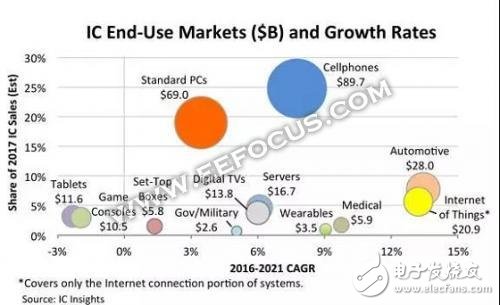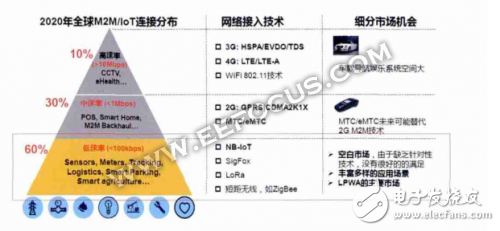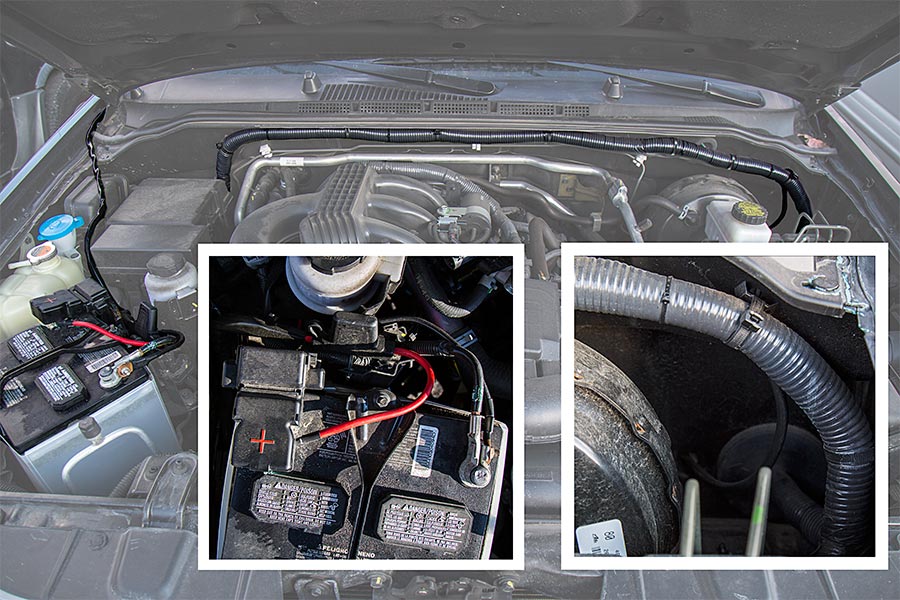The Internet of Things is a hot topic in the semiconductor field and is developing very rapidly. According to a forecast by IC Insights, a market research organization at the end of last year (2017), automotive electronics and the Internet of Things will be the fastest growing IC IC application market in recent years. The sales growth of these two types of ICs will be from 2016 to 2021. The overall growth rate of the IC market is 70% faster. Earlier, McKinsey also estimated that by 2025, the potential economic aggregate of IoT technology will reach 11.1 trillion US dollars.

Considering the application scenarios in life (such as remote meter reading, environmental monitoring, intelligent parking, location tracking, etc.), we need a kind of Internet of Things with wide coverage, low cost, simple deployment, and support for large connections. The Low-Power Wide-Area Network (LPWAN) came into being. Moreover, the number of Internet of Things led by these application scenarios will account for 60% of the total number of IoT connections.

The market is large and the application is wide. This cake is not tempting. This is not only a product battle between manufacturers, but also a dispute between several major technologies. After being strangled, three technologies emerged as the first echelon, namely NB-IoT, LoRa and eMTC, which have each established their own industrial ecological environment.
NB-IoT (Narrow Band Internet of Things) is a new technology specially designed for the LPWA IoT business. It has the characteristics of wide coverage, large connection, low power consumption and low cost, by sacrificing rate and time. Extend performance in exchange for more extreme IoT carrying capacity.
From the perspective of development history, the determination of this technical name has experienced many twists and turns, and a well-known domestic enterprise has also frequently appeared.
As early as the beginning of 2013, Huawei and related industry players and operators launched the development of narrowband cellular Internet of Things, and named it LTE-M (LTE for Machine to Machine). In May 2014, the IoT ultra-low-power cellular system project supported by Vodafone, China Mobile, Orange, Telecom Italia, Huawei, Nokia and other companies was established in the 3GPP GERAN working group. The name of LTE-M evolved into Cellular IoT. CIoT. In May 2015, Huawei and Qualcomm jointly announced the NB-CIoT (Narrow Band Cellular IoT) solution. In August 2015, Ericsson and several companies proposed the concept of NB-LTE (Narrow Band LTE). In September 2015, NB-CIoT and NB-LTE were merged to form NB-IoT.
Subsequently, in 2016, the NB-IoT R core protocol was frozen in four working groups: RAN1, RAN2, RAN3, and RAN4.
By November 2017, there were publicly available information that the number of commercial NB-IoT networks reached 21, including: VDF Spain, Germany, Germany, Germany, Germany, Telia, China Telecom, China Mobile, China Unicom, Korea LGU+, KT, VDF Netherlands, VDF Ireland, Australia VHA, United Arab Emirates ET, Hong Kong CMHK, Singapore M1, Italy TIM, South Africa Vodacom and so on. And said that in 2018 will reach 100.
It is not difficult to see that the development of NB-IoT has been smooth and smooth, on the one hand, thanks to the advantages of technology itself, such as: 1, wide coverage, in the same frequency band, NB-IoT is 20dB higher than the existing network gain, and the coverage area is enlarged. 100 times; 2, it has the ability to support massive connections, NB-IoT can support 100,000 connections in one sector; 3, lower power consumption, NB-IoT terminal module can last up to 10 years; low module cost.
On the other hand, the promotion of policies is also essential.
Since June 16, 2016, the NB-IoT technology protocol has been approved by the 3GPP Radio Access Network (RAN) technical specification group meeting, and China has subsequently issued a series of policies to support the development of NB-IoT.
In May 2017, the Ministry of Industry and Information Technology issued the "Telecom Network Numbering Plan (2017 Edition)". The new serial number added the Internet of Things network number, and the "140XX~144XX" was clearly identified as the Internet of Things network number.
On June 16, 2017, the Ministry of Industry and Information Technology issued the "Notice on Comprehensively Advancing the Construction and Development of Mobile Internet of Things (NB-IoT)", "Notice" for the NB-IoT standard, NB-IoT equipment, NB- from 2017 to 2020 The development of IoT chips, NB-IoT modules, NB-IoT tests, NB-IoT applications, and NB-IoT networks has deployed "quantitative" tasks.
On June 20, 2017, the Ministry of Industry and Information Technology issued the No. 27 announcement in 2017 to clarify the use requirements of the NB-IoT system frequency from three aspects.
1. In terms of frequency usage, the operator can deploy the NB-IoT using the allocated IMT system band of GSM or FDD mode without affecting the operation of the existing service. In the frequency configuration mode, the operator can Choose in-band mode, band mode or stand-alone mode.
2. In terms of radio frequency technical indicators, the announcement specifies the radio frequency technical indicators of the NB-IoT system macro base station, and clarifies that the terminal radio frequency technical indicators refer to relevant industry standards.
3. In terms of base station management, it is clear that the construction of NB-IoT base stations requires radio station licenses, and specific requirements for the setting of NB-IoT system base stations in the 800MHz, 900MHz, 1800MHz and 2100MHz bands are also proposed.
On August 7, 2017, the Ministry of Industry and Information Technology approved the application for the telecommunication network code number resource proposed by some units, and publicized the results of the 10th batch of “People's Republic of China Telecom Network Code Resource Use Certificate†in 2017, including IoT number segment allocation.
From the deployment progress and industrial ecology of the operators, the three major operators also showed an acceleration mode in the deployment of NB-IoT. At the end of June 2017, China Telecom took the lead in completing the 800MHz NB-IoT network deployment, and the 310,000 base stations of the entire network were upgraded synchronously, and the world's largest NB-IoT network was built. China Unicom announced the completion of the NB-IoT trial commercial network in Shanghai on May 15, 2017, and actively deployed the Internet of Things innovation business based on NB-IoT technology. China Mobile said in its 2017 semi-annual report that it will launch mobile IoT construction in 346 cities across the country, and in early August, release the 2017-2018 cellular Internet of Things (mainly NB-IoT and eMTC) engineering wireless and core network equipment design. With the feasibility study collection announcement, the estimated project cost is as high as 39.5 billion yuan. At the same time, an estimated 1.11 million antenna collections for mobile IoT equipment are released. It is expected to be commercially available nationwide within the year.
Of course, the development of NB-IoT is inseparable from the efforts of upstream manufacturers such as chips and modules. Some "net red" products in the industry, we must be very familiar with, such as: Huawei's Boudica120, Boudica150; Qualcomm's MDM9206; MediaTek's MT2625. The company interviewed by non-web reporters also has their own product deployment, QORVO's RF351x series products; ST is based on the Nucleo board's NB-IoT expansion board. In addition, companies such as Rideco, Intel, and ZTE Microelectronics also have their own chip plans.
However, the problem that cannot be ignored is that the NB-IoT is still not mature from chip to module to large-scale commercial. How to collect the fees of the three major operators is also in the discussion stage, and the industry still cannot form a consensus on the appropriate business model.
- Universal fit: compatible with all automobiles, boats and devices equipped with a 12V power source
- CIRCUIT PROTECTION: Power relay-safety protection and conversion circuit. Blade fuse protects the circuit when overcurrent or short circuit occurs.
- ILLUMINATED SWITCH: 3 pin on/off rocker switch with red indicator light when truing on, easy to turn on or off, has been passed test of 5, 000 times pressing.
- TWO AVAILABLE LEADS: With 2 sets of light output connectors for dual lighting fixtures less than 180W, the connection is more stable.
- PACKAGE INCLUDE:1 x Wiring Harness Kit ,1 x Instructions,
-


Light Wire Harness,Light Bar Wiring Harness,Led Light Bar Wiring Harness,Led Light Wiring Harness
Dongguan YAC Electric Co,. LTD. , https://www.yacentercns.com
![<?echo $_SERVER['SERVER_NAME'];?>](/template/twentyseventeen/skin/images/header.jpg)